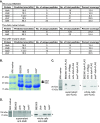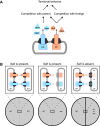Two independent pathways for self-recognition in Proteus mirabilis are linked by type VI-dependent export
- PMID: 23882014
- PMCID: PMC3735182
- DOI: 10.1128/mBio.00374-13
Two independent pathways for self-recognition in Proteus mirabilis are linked by type VI-dependent export
Abstract
Swarming colonies of the bacterium Proteus mirabilis are capable of self-recognition and territorial behavior. Swarms of independent P. mirabilis isolates can recognize each other as foreign and establish a visible boundary where they meet; in contrast, genetically identical swarms merge. The ids genes, which encode self-identity proteins, are necessary but not sufficient for this territorial behavior. Here we have identified two new gene clusters: one (idr) encodes rhs-related products, and another (tss) encodes a putative type VI secretion (T6S) apparatus. The Ids and Idr proteins function independently of each other in extracellular transport and in territorial behaviors; however, these self-recognition systems are linked via this type VI secretion system. The T6S system is required for export of select Ids and Idr proteins. Our results provide a mechanistic and physiological basis for the fundamental behaviors of self-recognition and territoriality in a bacterial model system.
Importance: Our results support a model in which self-recognition in P. mirabilis is achieved by the combined action of two independent pathways linked by a shared machinery for export of encoded self-recognition elements. These proteins together form a mechanistic network for self-recognition that can serve as a foundation for examining the prevalent biological phenomena of territorial behaviors and self-recognition in a simple, bacterial model system.
Figures




Similar articles
-
Identity gene expression in Proteus mirabilis.J Bacteriol. 2011 Jul;193(13):3286-92. doi: 10.1128/JB.01167-10. Epub 2011 May 6. J Bacteriol. 2011. PMID: 21551301 Free PMC article.
-
A Proposed Chaperone of the Bacterial Type VI Secretion System Functions To Constrain a Self-Identity Protein.J Bacteriol. 2018 Jun 25;200(14):e00688-17. doi: 10.1128/JB.00688-17. Print 2018 Jul 15. J Bacteriol. 2018. PMID: 29555703 Free PMC article.
-
Genetic determinants of self identity and social recognition in bacteria.Science. 2008 Jul 11;321(5886):256-9. doi: 10.1126/science.1160033. Science. 2008. PMID: 18621670 Free PMC article.
-
Merging mythology and morphology: the multifaceted lifestyle of Proteus mirabilis.Nat Rev Microbiol. 2012 Nov;10(11):743-54. doi: 10.1038/nrmicro2890. Epub 2012 Oct 8. Nat Rev Microbiol. 2012. PMID: 23042564 Free PMC article. Review.
-
Proteus mirabilis and Urinary Tract Infections.Microbiol Spectr. 2015 Oct;3(5):10.1128/microbiolspec.UTI-0017-2013. doi: 10.1128/microbiolspec.UTI-0017-2013. Microbiol Spectr. 2015. PMID: 26542036 Free PMC article. Review.
Cited by
-
Intraspecies Competition in Serratia marcescens Is Mediated by Type VI-Secreted Rhs Effectors and a Conserved Effector-Associated Accessory Protein.J Bacteriol. 2015 Jul;197(14):2350-60. doi: 10.1128/JB.00199-15. Epub 2015 May 4. J Bacteriol. 2015. PMID: 25939831 Free PMC article.
-
Transcriptional analysis of the MrpJ network: modulation of diverse virulence-associated genes and direct regulation of mrp fimbrial and flhDC flagellar operons in Proteus mirabilis.Infect Immun. 2015 Jun;83(6):2542-56. doi: 10.1128/IAI.02978-14. Epub 2015 Apr 6. Infect Immun. 2015. PMID: 25847961 Free PMC article.
-
Distribution and diversity of type VI secretion system clusters in Enterobacter bugandensis and Enterobacter cloacae.Microb Genom. 2023 Dec;9(12):001148. doi: 10.1099/mgen.0.001148. Microb Genom. 2023. PMID: 38054968 Free PMC article.
-
Cell Shape and Population Migration Are Distinct Steps of Proteus mirabilis Swarming That Are Decoupled on High-Percentage Agar.J Bacteriol. 2019 May 8;201(11):e00726-18. doi: 10.1128/JB.00726-18. Print 2019 Jun 1. J Bacteriol. 2019. PMID: 30858303 Free PMC article.
-
Kind discrimination and competitive exclusion mediated by contact-dependent growth inhibition systems shape biofilm community structure.PLoS Pathog. 2014 Apr 17;10(4):e1004076. doi: 10.1371/journal.ppat.1004076. eCollection 2014 Apr. PLoS Pathog. 2014. PMID: 24743836 Free PMC article.
References
-
- Wilson EO. 2000. Sociobiology: the new synthesis, 25th anniversary edition. Belknap Press, Cambridge, MA
-
- Dienes L. 1946. Reproductive processes in Proteus cultures. Proc. Soc. Exp. Biol. Med. 63:265–270 - PubMed
-
- LeRoux M, De Leon JA, Kuwada NJ, Russell AB, Pinto-Santini D, Hood RD, Agnello DM, Robertson SM, Wiggins PA, Mougous JD. 2012. Quantitative single-cell characterization of bacterial interactions reveals type VI secretion is a double-edged sword. Proc. Natl. Acad. Sci. U. S. A. 109:19804–19809 - PMC - PubMed
Publication types
MeSH terms
Substances
Associated data
- Actions
LinkOut - more resources
Full Text Sources
Other Literature Sources
Molecular Biology Databases
